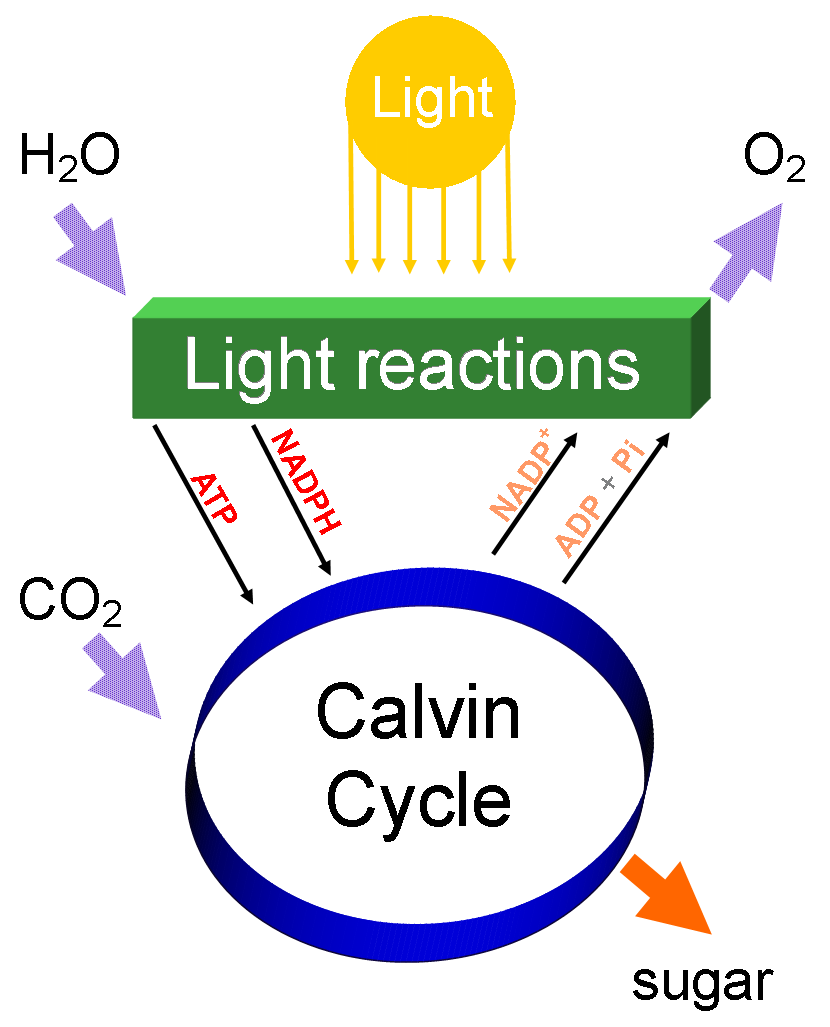Look Dad, I'm As Tall As You!

All life depends on the ability for green plants to trap and
utilize the sun's energy and convert this energy into useful
material such as sucrose, starch, and cellulose. Saccharum
officinarum is particularily efficient in producing an excess
amount of sucrose. In fact This process of taking in light energy and
converting it into other substances is called photosynthesis.
Photosynthesis allows plants to make their own food which deems
them as autotrophs. For further information on different
organisms that use photosynthesis to get their nutrients check
out the chocolate producing
Cacao Tree and the lawn pest the
Dandelion.

In order for photosynthesis to occur light energy must be trapped from sun rays. This takes place within two photosystems depicted by the green 'light reactions' box in the diagram. These light reactions are also known as the light-dependant reaction. Plants contain special structures within their cells called chloroplasts which control and contain the photosynthetic reaction taking place. Chloroplasts are composed of molecules called chlorophyll which aids in trapping light energy. Chlorophyll is the pigment which gives plants their green color. Once the plants traps the light energy it enters into the portion of photosynthesis called the Calvin Cycle which is the light-independent reaction. The Calvin Cycle takes the energy captured during the light dependent reaction to convert water and carbon dioxide into glucose and oxygen that can be used by the organism.
Transportation of water throughout the sugar cane plant is
another important concept to understand when it comes to
learning how plants grow.
 Water is transported up the stem
from the roots by specialized cells called the xylem.
Xylem has the ability to pull water up the stem by the
properties of transpiration, adhesion, cohesion, and tension.
Water evaporates from the leaves leading to an increased solute concentration. This allows the water from the xylem to
move into the mesophyll cells because water always moves from an
area of high water potential to a lower water potential.
Phloem, on the other hand, deals with the transportation of
sugar down the plant from the source, usually the leaves, to the
sink, any growing storing or metabolizing tissue. I only
grazed the tip of the iceberg on transportation. If you
would like to learn more about this interesting aspect of plant
growth please go to
Transportation on the web.
Water is transported up the stem
from the roots by specialized cells called the xylem.
Xylem has the ability to pull water up the stem by the
properties of transpiration, adhesion, cohesion, and tension.
Water evaporates from the leaves leading to an increased solute concentration. This allows the water from the xylem to
move into the mesophyll cells because water always moves from an
area of high water potential to a lower water potential.
Phloem, on the other hand, deals with the transportation of
sugar down the plant from the source, usually the leaves, to the
sink, any growing storing or metabolizing tissue. I only
grazed the tip of the iceberg on transportation. If you
would like to learn more about this interesting aspect of plant
growth please go to
Transportation on the web.
Now that we've learned all we need to know about sugar cane's
nutrition, follow me on our journey to find out where sugar cane
is found in
Habitat & Geography.